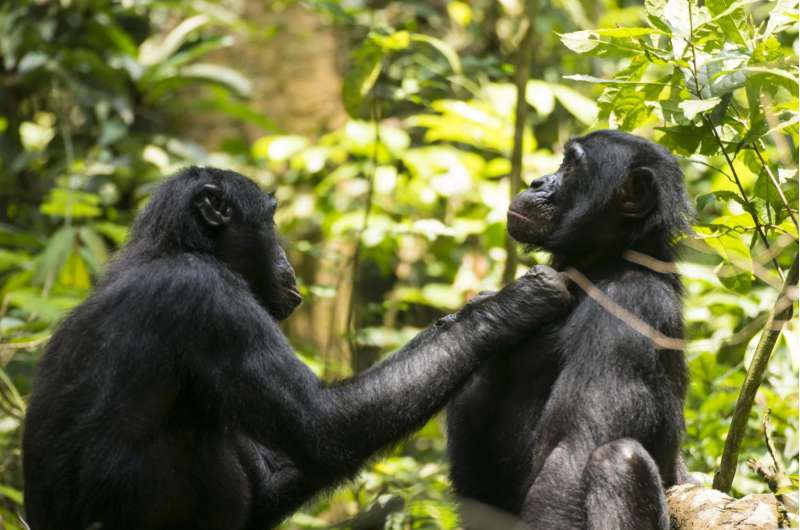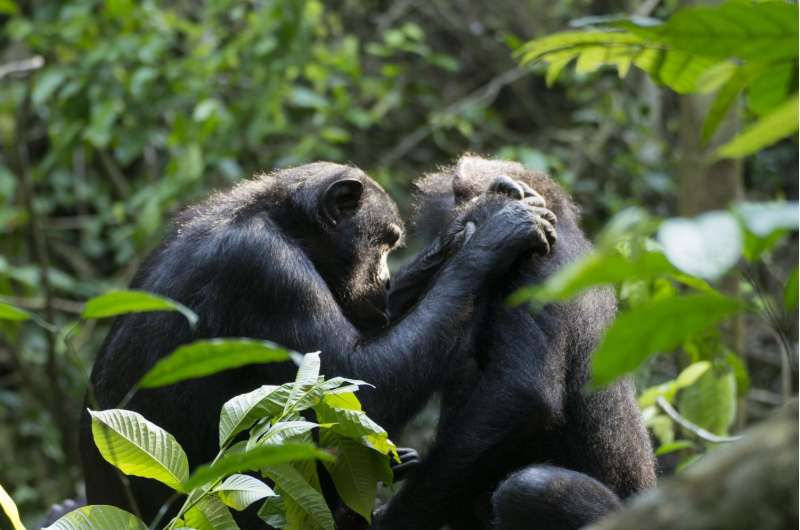Aging bonobos in the wild could use reading glasses too

As people age, they often find that it's more difficult to see things up close. Reading a newspaper suddenly requires a good pair of reading glasses or bifocals. Now, researchers reporting in the Cell Press journal Current Biology on November 7 find that the same goes for bonobos, one of human's closest primate relatives along with chimpanzees, even though they obviously don't read.
This long-sightedness in bonobos is most evident as older animals engage in grooming their peers, the researchers say. The older they get, the longer they stretch their arms from the rest of their bodies as they groom.
"We found that wild bonobos showed the symptoms of long-sightedness around 40 years old," says Heungjin Ryu of the Primate Research Institute of Kyoto University. "We were surprised that the pattern found in bonobos is strikingly similar to the pattern of modern humans. This suggests that senescence of the eyes has not changed much from the Pan-Homo common ancestor, even though the longevity of modern humans is far longer than that of chimpanzees and bonobos."
Ryu says that researchers had already noticed this trend of bonobos needing longer distances for grooming before. There had also been anecdotal reports in chimpanzees. It's just that no one paid much attention to it.
"One day, I was with another researcher and observed the oldest male bonobo Ten (TN) grooming Jeudi (JD)," Ryu recalls. "TN had to stretch his arm to groom JD, and only when he found something on JD's body would he come close to remove it using his mouth. It was funny to see how he groomed."
While it might have looked amusing, the researchers began to appreciate that this long-sightedness, caused by a decline in the refractive power of the crystalline lens with age, might also have serious consequences for the survival and social lives of those older animals.
To learn more, the researchers used digital photographs to measure the grooming distance of 14 wild bonobos of various ages, ranging from 11 to 45 years old. They also examined how grooming distance varied in relation to age and sex in bonobos and compared it with the nearest focus distance in humans.
The measurements showed that the grooming distance increased exponentially with age. In one case, an old video of one of the bonobos, named Ki, enabled them to show that his eyesight had worsened over time.
"The results we found were very surprising even for us," Ryu says. "When I started to collect data, I did not expect that age could be such a strong predictor of long-sightedness."

Ryu says that long-sightedness might hinder the social lives of older individuals, explaining why older individuals aren't favored when it comes to selecting grooming partners. People who grow long-sighted with age also have particular trouble seeing in the dark, he adds. That could be a big challenge for the bonobos, living as they do in the shade of the rainforest canopy.
As for us humans, the findings in our bonobo relatives suggest that long-sightedness isn't a consequence of the modern lives we lead and all that time spent reading or staring at a screen. Rather, it's a natural process of aging rooted deep in our past. Ryu says that they plan to continue studying aspects of aging in bonobos to learn more about them and us.
More information: Current Biology, Ryu et al.: "Long-sightedness in old wild bonobos during grooming" www.cell.com/current-biology/f … 0960-9822(16)31068-5 , DOI: 10.1016/j.cub.2016.09.019
Journal information: Current Biology
Provided by Cell Press



















